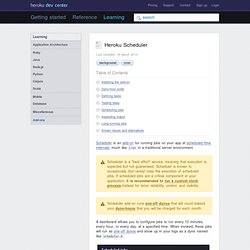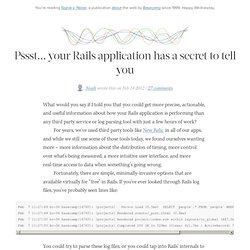

Scheduler. Background cron Table of Contents Scheduler is an add-on for running jobs on your app at scheduled time intervals, much like cron in a traditional server environment.

Scheduler is a "best effort" service, meaning that execution is expected but not guaranteed. Scheduler is known to occasionally (but rarely) miss the execution of scheduled jobs. If scheduled jobs are a critical component of your application, it is recommended to run a custom clock process instead for more reliability, control, and visibility. Scheduler add-on runs one-off dynos that will count toward your dyno-hours that you will be charged for each month.
A dashboard allows you to configure jobs to run every 10 minutes, every hour, or every day, at a specified time. Installing the add-on To use the Heroku Scheduler, install the add-on: heroku addons:add scheduler:standard Dyno-hour costs Scheduler runs one-off dynos that will count towards your dyno-hours for the month. Defining tasks #! Testing tasks heroku run rake update_feed. Ruby on Rails Tutorial: Learn Rails by Example book and screencasts by Michael Hartl. Michael Hartl Contents Foreword My former company (CD Baby) was one of the first to loudly switch to Ruby on Rails, and then even more loudly switch back to PHP (Google me to read about the drama).

This book by Michael Hartl came so highly recommended that I had to try it, and the Ruby on Rails Tutorial is what I used to switch back to Rails again. Though I’ve worked my way through many Rails books, this is the one that finally made me “get” it. The linear narrative is such a great format. Enjoy! Derek Sivers (sivers.org) Founder, CD Baby Acknowledgments The Ruby on Rails Tutorial owes a lot to my previous Rails book, RailsSpace, and hence to my coauthor Aurelius Prochazka. I’d like to acknowledge a long list of Rubyists who have taught and inspired me over the years: David Heinemeier Hansson, Yehuda Katz, Carl Lerche, Jeremy Kemper, Xavier Noria, Ryan Bates, Geoffrey Grosenbach, Peter Cooper, Matt Aimonetti, Gregg Pollack, Wayne E.
About the author Copyright and license 1.1 Introduction. Pssst... your Rails application has a secret to tell you. What would you say if I told you that you could get more precise, actionable, and useful information about how your Rails application is performing than any third party service or log parsing tool with just a few hours of work?

For years, we’ve used third party tools like New Relic in all of our apps, and while we still use some of those tools today, we found ourselves wanting more – more information about the distribution of timing, more control over what’s being measured, a more intuitive user interface, and more real-time access to data when something’s going wrong. Fortunately, there are simple, minimally-invasive options that are available virtually for “free” in Rails. If you’ve ever looked through Rails log files, you’ve probably seen lines like: Feb 7 11:27:49 bc-06 basecamp[16760]: [projects] Person Load (0.5ms) SELECT `people`.* FROM `people` WHERE `people`. `id` = ? All the details you could want to know, after the jump… Dipping into the well of knowledge Storing the data. Try Airbrake FREE for 30 days when you sign up for a paid plan. Try Airbrake FREE for 30 Days All paid plans come with: Deploy Tracking GitHub SSL Support Pivotal Integration Much More Monthly Plans All paid Airbrake plans work on a monthly billing cycle, and the prices shown on this page reflect the monthly costs of using the service.

Upgrade or Downgrade Anytime. Web Application Performance Management (APM) Building and Scaling a Startup on Rails: 12 Things We Learned the Hard Way - Axon Flux // A Ruby on Rails Blog. There are a bunch of basic functional elements to building out a popular Rails app that I've never really seen explained in one place, but we had to learn the hard way while building Posterous.

Here's a rundown of what we've learned, in the hopes that some Google linkjuice may bring an intrepid wanderer to this forlorn part of the woods and help you out. Static StorageS3 is awesome. Yes, you can host everything off S3. Is it a little more expensive? Probably. Images, files, whatever. HTTP Cache ControlThe HTTP protocol lets you tell browsers what static content they can cache.
SearchYou're not going to run full text search out of your DB. Storage engine matters, and you should probably use InnoDB MyISAM is marginally faster for reads, but InnoDB will make you more crash resistant and will not lock tables on writes. Fix your DB bottlenecks with query_reviewer and New RelicThis basically saves your ass completely. Above is a screenshot from query_reviewer. Then what happens? Noahd1/oink - GitHub.